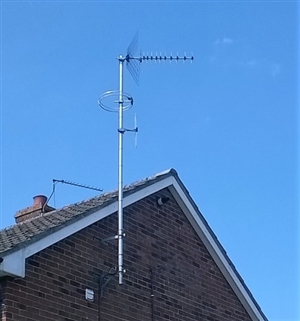
Time was when Band 2 FM sound transmissions were nearly all horizontally polarized. With the growth of local radio from the late 1960s, an aerial that could receive signals from all directions seemed a good idea. The drawback with this type of aerial is that it has poor sensitivity, typically 2 dB to 3 dB below that of a single dipole aerial mounted perpendicular to the direction of the transmitter.
Years ago, when these were still quite new, an aerial contractor persuaded me to have one fitted, making great claims over its performance with signals from all directions. But I was disappointed with the results, and later replaced it with a four-element yagi array, which proved much better.
With the rapid increase in usage of FM radio for casual listening on portable receivers and in car radios, nearly all the main FM transmitters have been adapted to give a mixed polarisation, i.e. including a vertical element. Indeed, some transmitters use vertical polarization only, particularly stations that serve a locality where the signal from the main station is weaker than desirable - like a local station we have near where I live.
So a horizontal "omni" aerial in this area is hardly suitable for either the weak signal from the main transmitter or the vertically polarized signal from the local transmitter. A vertically-mounted single dipole Band 2 aerial would be omnidirectional and give better results. One rarely sees these, though single dipole Band 3 aerials are becoming increasingly common.
Yet I still occasionally see new circular aerials being installed, including on communal aerial installations serving tenement buildings. One would presume that these are installed by professionals who would know what they are doing.
Is the provision of FM Band 2 reception on a communal system a bit of a perfunctory operation nowadays, anyway? My guess is that the connoisseurs of quality sound radio would use the digital services available on either Freeview or Satellite, as I do. Casual listeners would go for DAB, where quality is compromised by the ever-increasing range of programmes, at the expense of bandwidth.
Is "gimmick value" working here? Would anyone from the TV and aerial trade like to comment?